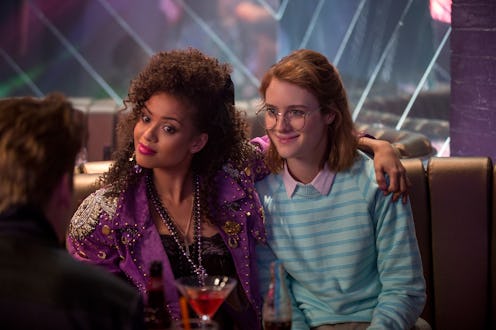
It's been nearly two years since the Black Mirror Christmas special was released and even longer since a full season has been put out for the consuming. The wait has been worth it, at least in regard to volume. On Friday, Oct. 21, Netflix released Black Mirror Season 3 — six new episodes of the meditative British anthology series. In the past, a typical Black Mirror episode used human emotion to expose some sinister or at least callous side to technological advancement. In Season 3, the series is dipping into new genres and tones. In the "San Junipero" episode of Black Mirror , Gugu Mbatha-Raw and MacKenzie Davis play two young women who meet in a New Wave club under circumstances that slowly unfold for the audience. The result is a poignant piece of fiction about the intersection between life and death. I'll be discussing plot details of "San Junipero" below, so stop here if you're avoiding spoilers.
Though it also works well for the show's creepier narratives, Black Mirror's method of handing the audience the science fiction conceit of the story piece-by-piece is incredibly effective in a love story. With no context for why Kelly (Mbatha-Raw) and Yorkie (Davis) were concerned about a countdown clock that ends at midnight or what a setting that's clearly meant to represent the 1980s is doing in a show that's usually about humanity's future, I was free to focus on the actors and their chemistry — the magnetic pull between wild, confident Kelly and reserved, nervous Yorkie.
After a few meetings in the same club, Yorkie lets her attraction overrule her hesitation. But, the night after she and Kelly sleep together for the first time, Yorkie can't find her there. A persistent guy who Kelly had been avoiding before tells Yorkie to check other eras for her, and Yorkie does just that. She finds her in another decade playing some Dance Dance Revolution-type game with Alanis Morissette wailing in the background. I know what time travel looks like in movies and TV, and though Kelly and Yorkie move through the years like water, it's clear that's not what they're dealing with.
As the women grow closer, the truth becomes clearer. They talk to each other about meeting in another place, confirming that San Junipero is a town and a consciousness that they're both just visiting. Yorkie is reluctant, fearing that the magic won't extend that far. Will Kelly even like her? She consents eventually, and the plot resumes in a more familiar world. Kelly, an elderly woman with terminal cancer, travels in a van with her aid. At another facility, she's shown into a room occupied by Yorkie, a quadriplegic who's elected to end her life. Yorkie had mentioned her fiancé Greg; in reality, he's a kind nurse who will marry Yorkie so that she can have her wishes fulfilled legally. Kelly begs Greg to hook her and Yorkie up to San Junipero for a few minutes so they can talk. Kelly offers to marry Yorkie herself, and pastor performs the ceremony right then and there.
San Junipero is revealed to be a synthesized afterlife option. There's no real city called that, and, obviously, no such afterlife technology exists like the one shown. There was a real Spanish saint named Junípero Serra who founded missions all over California — and with the beachy setting, it's possible that the fictional San Junipero is a California town. But it has no obvious inspiration. The aging and the infirm are able to visit on a trial basis, to see if they'll opt for it in the end. It appears that most San Junipero residents choose the era when they felt young and invincible, so presumably Kelly and Yorkie were in their early '20s in the late '80s. The carefree nature of the place obscures reality. For Kelly, it's that her husband of 49 years passed and passed on San Junipero because their daughter died young and didn't have that option. And for Yorkie, it's that she came out to her parents as a young woman, was rejected, and got into a terrible, life-changing accident immediately after.
There's nothing holding Yorkie back from choosing this consciousness. In San Junipero, she's able-bodied and unconstrained. And she had no family she feels guilty about abandoning in death. It's different for Kelly. Though she'd experienced attraction to women too, she loved her husband devotedly. It feels like a betrayal to choose some engineered happiness over the nothingness that he picked.
If Kelly had just partied through San Junipero like she'd planned, she probably would have elected a traditional death. But she met Yorkie and connected with her — a person who had a hard and relatively loveless life, getting a second shot at the youth she deserved. Kelly can't do anything more for her husband and her child. Death is a deeply personal matter, and guilt is a fruitless emotion. After she passes, Kelly's body is laid to rest with her family, and her consciousness is uploaded to San Junipero. Decked out in bedazzled, puff-sleeved wedding dresses, Kelly and Yorkie speed down the coast in a red convertible, free from everything.
Episodes like this are exactly what Black Mirror needs to stay fresh and surprising. "San Junipero" is a hopeful deviation from the usual technological cautionary tale and an episode I'll definitely be returning to in the future.
Images: David Dettmann (2),Laurie Sparham/Netflix